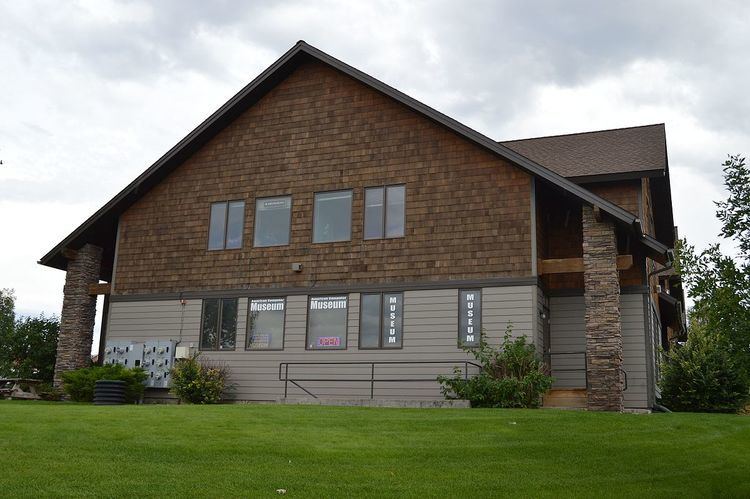Established May 1990 Phone +1 406-582-1288 | Website www.compustory.com Founded 1990 | |
 | ||
Address 2023 Stadium Dr #1A, Bozeman, MT 59715, USA Hours Open today · 12–4PMTuesday12–4PMWednesday12–4PMThursday12–4PMFriday12–4PMSaturday12–4PMSunday12–4PMMondayClosed Similar Palisade Falls, Museum of the Rockies, Rocky Mountains, Bridger Bowl Ski Area, Gallatin History Museum | ||
The American Computer & Robotics Museum, formerly known as the American Computer Museum, is a museum of the history of computing, communications, artificial intelligence & robotics that is located in Bozeman, Montana, USA. It was founded in May 1990 by Barbara and George Keremedjiev as a non-profit organization and will be celebrating its 25th anniversary in May 2015. The museum is also known as the American Computer & Robotics Museum. The museum was originally intended to have been located in Princeton, New Jersey, but the location was changed when the founders moved to Bozeman. It is likely the oldest extant museum dedicated to the history of computers in the world. The Computer Museum in Boston opened first, but it closed in 1999.
Contents
The museum's mission is:
"To collect, preserve, interpret, and display the artifacts and history of the information age."
Some of the Permanent Exhibits
Awards
In 1994 the American Computer Museum won the Dibner Award for Excellence in Museum Exhibits from the Society for the History of Technology.
The American Computer Museum presents (in association with the College of Engineering, the College of Letters & Science, the Humanities Institute and the Computer Science Department of Montana State University) the George R. Stibitz Computer & Communications Pioneer Awards, named for Dr. George R. Stibitz, who first used relays for computation at Bell Laboratories in 1937 and the Edward O. Wilson Biodiversity Technology Pioneer Awards, named for Harvard Emeritus Professor Dr. Edward O. Wilson.
- Stibitz Awards: Arthur Burks, Chuan Chu, Jack Kilby, Jerry Merryman, James Van Tassel, Maury Irvine, Eldon Hall, Ted Hoff, Federico Faggin
- Stibitz Awards: Ed Roberts, Doug Engelbart
- Stibitz Awards: James Harris, Vinton G. Cerf, Robert E. Kahn
- Stibitz Awards: Steve Wozniak, Tim Berners-Lee, Ray Tomlinson
- Stibitz Awards: Ted Hoff, Federico Faggin and Stan Mazor (together)
- Stibitz Awards: Ralph Baer, Martin Cooper, Leroy Hood, Klein Gilhousen, James Russell, Jon Titus
- <none awarded>
- <none awarded>
- Stibitz Awards: Ross Perot, Paul Baran, John Blankenbaker
- Stibitz Awards: Edward O. Wilson
- <none awarded>
- <none awarded>
- Wilson Awards: Ignacio Rodriguez-Iturbe, Steve Running, Michael Soulé, David Ward
- Stibitz Awards: Barbara Liskov, Max Mathews, Steve Sasson
Wilson Awards: Sir Alec Jeffreys, Lynn Margulis, David Quammen - Stibitz Lifetime Achievement Award: Federico Faggin
Wilson Awards: Jim Lotimer, John Kress, Peter Belhumeur, David Jacobs - Stibitz Awards: Robert Metcalfe, Vic Hayes
Wilson Awards: Paul Anastas, May Berenbaum, Gary Strobel - Stibitz Awards: Walt Disney, Chuck Hull, John Henry Holland
Wilson Awards: Frans de Waal, Jean B. Sweeney - Stibitz Awards: Eric Horvitz, Douglas Hofstadter, Hans Moravec, Edward Feigenbaum, David Andes, Cynthia Breazeal
Wilson Awards: Rebecca D. Costa, Dorothy Hinshaw Patent, Cathy Whitlock, John Charles Priscu - Stibitz Awards: David Ferrucci, Robert Gunderson
Wilson Awards: Janine Benyus, Kjetil Våge, Laurie Marker
Collection
Items in the museum's collection include the following.
